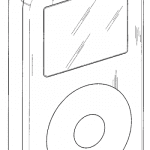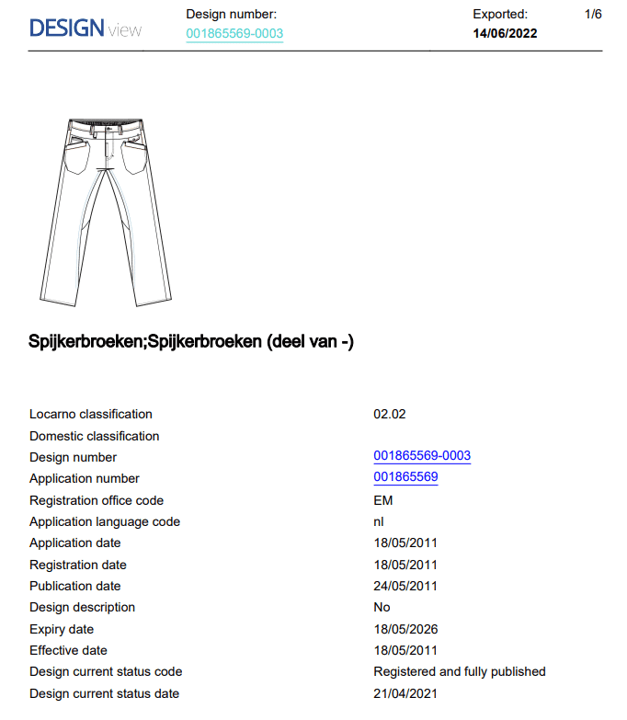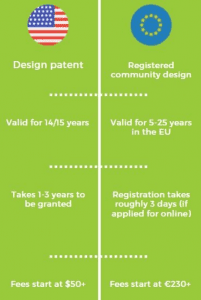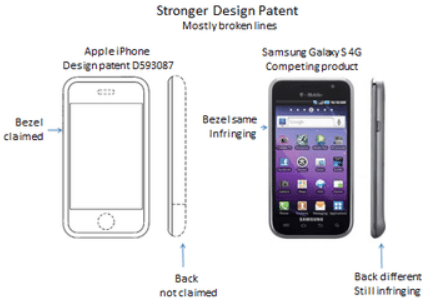Criteria for getting a Community Design Registered
There are three elements to make sure that a subject design claimed meets the criteria of the EUIPO:
- Design Criteria
- Novelty and Individual Character
- Representation
Design Criteria
A design can only be registered if that design is applied to a particular product. Any design not applied to a product can’t be registered. For example – Mere showing zig-zag pattern on a white sheet is not allowed to be registered. But the same zig-zag pattern if applied to a bottle may be registered. No protection is provided till a design is applied to a product. If the product has an ability to be disassembled and reassembled, then those parts of the are also considered as a product and any design applied on them can be registered.
The design should not be against public policy, and certain standards. Any deign that may portray or promote violence or discrimination based on sex, racial or ethnic origin, religion or belief, disability, age, or sexual orientation is not allowed to be registered by EUIPO.
Novelty and Individual Character
A design is allowed to be registered only if its novel and has individual character. A design is considered to be new if no identical design has been disclosed before it. If two designs have substantial similarities and they differ only in insignificant details, they will still be viewed as identical. Hence, the design to be protected should be different from prior designs, which defines the individual character of the design.
Representation
The purpose of representing is to display all the features of the design that an applicant is trying to protect. An applicant must ensure that the features of your design are displayed as thoroughly as possible in order to get the maximum protection he can for the design. Any detail missed out in the design that was not properly represented by the applicant will be considered as a fault from his side.
Therefore, it is important that an applicant provides an accurate and proper representation of the design carefully and thoroughly. The representation quality is the foremost factor for the protection of design.
In practical terms, the quality of the representation must allow the design to be reduced or enlarged to a size no greater than 8 cm by 16 cm to be published in Community Designs Bulletin and to enter in the Community Designs register.
Guidelines for filing an RCD application
Drawing Views
An applicant is allowed to file a maximum of up to ten different views to represent your design: seven protected views and three non-protected views. Different views such as plain, in elevation, cross-sectional, in perspective or exploded views can be provided for the same.
Colours
The applicant must maintain uniformity while preparing the representations. If the applicant is providing black and white representations, then all the representations must be black and white. And, if the applicant is coloured representations, then all the representations must be coloured. EUIPO does allow to mix colour types, e.g., to file 2 views in black and white and 2 in colour for the same design.
Background
While preparing the representation for your design, it must be made sure that the representation has a neutral background and does not contain anything other than the subject design. The design should be clearly distinguishable from its background.
Identifiers
There are certain identifiers that should be used to represent different aspects of the design. some of these identifiers are:
- Broken Lines – Indicating elements that are not part of the claimed design and for which no protection is sought.
- Solid Lines – Indicating the parts/features of the claimed design for which protection is sought
- Colour Shading and Blurring – Excluding several features from protection
- Separations - Indicating that the precise length of the design is not claimed
These indicators are self-explanatory. No explanatory text, indications, wordings, or additional symbols may be used in the design views.
National or Europe-wide protection?
Just like utility patents, design patents are also enforceable in the states in which application has been applied for. Depending upon the commercialization strategy of a person, he must decide whether to file for one or more particular states or file for protection in whole of EU member states.
The decision can be based on the business area of the applicant. If the business area is a single state, then it makes sense to just file for one state. But if business is being conducted in more states or planning is to expand the business, then decision for filing is to be made accordingly. In case of application for only a single state, the exclusive right will be for just that state only. The applicant won’t be able to prevent anyone from copying it in other EU countries.
RCD Advantages
- RCDs have a longer period of protection.
- They get protection in various member states and certain non-member states of EU.
- Even though they are protected in various states, they are governed by a single legal system and thus providing strong and uniform protection throughout the European Union.
- It is very easy, and fast process to get an RCD registered. It is one application, one language, one file to manage system.
- Along with it, it provides an option to protect multiple designs in a single application.
- Registration fee is very less. It is even less to get multiple designs registered.
- No cost is required to do get a translation done.
EUIPO or WIPO?
There are two routes to get a Community Design registered. An applicant can proceed directly to EUIPO or else, he can approach the International Bureau of the World Intellectual Property Organization (WIPO) in which case you must designate the European Union.
Even if the application is entered through WIPO, the application gets examined by EUIPO.
Formal Requirements
During the examination, an examiner goes through the application to perform formalities check. If during the examination, an issue is detected by the examiner, the examiner has to communicate the issue to the applicant or his representative. A period of two months is provided for an applicant/representative of the applicant to respond to the examiner’s objection. This period can be extended upon request according to the procedure of EUIPO.
Generally, EUIPO automatically approves the first request for extension. In case of a consecutive extension, a proper reason and justification is to be provided. Upon satisfaction of the examiner, the request may be granted.
If the issue raised by the examiner is not solved according to the satisfaction of the examiner, then the examiner has the right to refuse the registration of the subject design application either in its entirety or, in the case of a multiple application, for some of the designs. In case the applicant does not agree with the decision of the examiner, he has the right to appeal in court.
Cost of a Design Patent
Getting a patent registered can be a costly process. An applicant must be aware that how much a design patent costs. The cost can be an important factor to reach the decision of whether to file a patent or not; and which type of patent to be filed. To answer the issue of how much are design patents, it can be described in the way that every state has different costs for different stages, starting from the filing of the patent until the grant of the patent.
US
In the US, an applicant is required to pay the design patent application fee, examination fees & search fee along with the application for a design patent. For small entities, all these fees are reduced by half. And for Micro Entities, all the fees are one-fourth the regular fees.
An applicant can obtain the exact fees for different stages from the official website of USPTO. Click on the link to check the fee structure – Patent Fees
Maintenance fees in utility patents can be seen quite commonly but, do design patents have maintenance fees? To answer this, after the grant of a design patent, no maintenance fees are required to maintain the patent. It remains in force till its expiry. Also, the doubt of how long a design patent is good for can be cleared from the fact that no maintenance is required in case of design patents as discussed above.
Europe
Getting a community design registered in cheaper than getting a Design patent registered in US. Even the time period for getting a grant in less as compared to US. This is done to allow an applicant to start using the design for commercialization quickly.
For a registered Community design (RCD) application, there are three types of fees, viz. registration, publication, and deferment fees.
An applicant can obtain the exact fees for different stages from the official website of EUIPO. Click on the link to check the fee structure – Design Fee
To better protect your design in Europe and increase the scope of protection that you need, an applicant can file multiple design patent applications, each covering a different scope of a design. Fee structure is very cost-effective in Europe and fees for additional designs is less.
The fees payable depend on two factors:
- Whether the design application is claiming one design or more than one design
- Whether the publication of designs will be deferred or not.
The design fee structure can be explained as:
- A basic fee for a single design
- The same basic fee for the first design in case of multiple designs
- A reduced fee for the second to tenth designs
- A further fee reduction per design, from the eleventh design onwards.
The exact fee can be calculated based on the number of designs and any kind of deferment, if needed. The notable differences between European registered community design & US design patents can be seen below:













